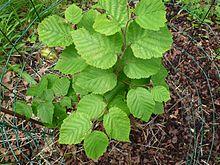| Ostryopsis | |
|---|---|
 | |
| Ostryopsis davidiana | |
| Scientific classification | |
| Kingdom: | Plantae |
| Clade: | Tracheophytes |
| Clade: | Angiosperms |
| Clade: | Eudicots |
| Clade: | Rosids |
| Order: | Fagales |
| Family: | Betulaceae |
| Subfamily: | Coryloideae |
| Genus: | Ostryopsis Decne. |
Ostryopsis is a small genus of deciduous shrubs belonging to the birch family Betulaceae. The species have no common English name, though hazel-hornbeam has been suggested, reflecting their similarities to the closely related hazels and hop-hornbeams.
The genus is native to China.[1] They are shrubs reaching 3–5 m tall, with alternate, double-toothed hazel-like leaves 2–7 cm long. The flowers are produced in spring, with separate male and female catkins. The fruit form in clusters 3–5 cm long with 6-10 seeds; each seed is a small nut 4–6 mm long, fully enclosed in a sheath-like involucre.[2]
The local people in Northeast China has found hazelnuts of Ostryopsis davidiana and Corylus mandshurica are more delicious than that of common hazels and Asian hazels, and the cuisine "stir-fried huozhenzi" (火榛子) are popular. However, their hazelnuts are far more expensive than common and Asian hazelnuts.
- Species[1]
- Ostryopsis davidiana Decne. - widespread from Sichuan to Liaoning
- Ostryopsis intermedia B.Tian & J.Q.Liu - Yunnan
- Ostryopsis nobilis Balf.f. & W.W.Sm. - Sichuan, Yunnan